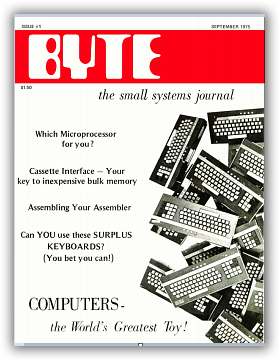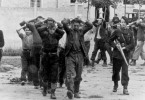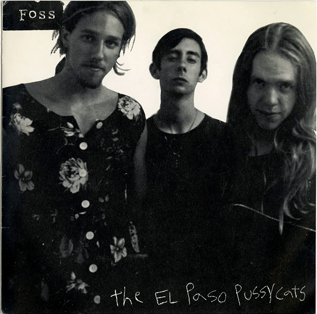Special to aNewDomain.net — Here’s John Barry, who worked with the late Wayne Green at the ham radio magazine that preceded the original BYTE in the 1970s. He provides a tremendous tribute to BYTE’s first founder and publisher. Read John Barry’s story below detailing the thrills, spills and chills of starting the world’s first computer magazine — and find a personal portrait of Green, too.
Serial entrepreneur, tech visionary and contrarian, Wayne Green, died recently at age 91 after a long often-controversial life. Green co-founded Byte, the progenitor of all “microcomputer” magazines. That was in 1975 in Peterborough, NH, the location that was inspiration for Thornton Wilder’s Our Town. Fifteen years earlier, Wayne started 73, a magazine for ham radio enthusiasts. This was after serving an apprenticeship at CQ, a ham mag that exists to this day. For what it’s worth, “73” is a ham signoff meaning “best regards.”
Ham was huge back then, counting King Hussein of Jordan among its adherents. The King and Green met via 73, and a signed photo of the monarch hung on Green’s office wall, inscribed: ‘To my friend Wayne Green.’ Before Green changed the name of his company to Wayne Green, Inc., it was 1001001, which is 73 in binary.”
Another BYTE founder was Green’s ex-wife, Virginia Londner, in whose name the company started. Years earlier Green’s libertarian streak had gotten him in trouble with the IRS, so the couple put everything in Londner’s name to avoid possible garnishment of his income. She had put up most of the money anyway. When the two had a falling out, she took BYTE with her. Never one to back down from a challenge, Green started a competing magazine. He wanted to call it Kilobyte (as in “kill BYTE”) but was unable to use that name, because BYTE had trademarked it as the name for a cartoon series. So Green instead launched Kilobaud in January 1977, eventually changing the name to Kilobaud Microcomputing, and finally Microcomputing.
I’m John Barry. As I recall, the original managing editor of Kilobaud, an aspiring fiction writer, left the magazine in the summer of 1977. I got wind of his departure and called about the job opening. A man answered the phone. No sooner had I asked about the position when the voice abruptly interrupted: “Do you know anything about computers?” “No,” I responded. “Forget it!” Click. That was Wayne. But I persisted and eventually got the job, which I held until the summer of 1980.
In a way, I was in at the beginning of the PC revolution, if only peripherally. Microcomputers — as PCs where then called — were just becoming available to the public. Most people who purchased them were electronics enthusiasts and tinkerers. Kilobaud’s focus was mainly on so-called hobbyists and home brewers, geeks who built their own circuit boards and soldered, and software nerds writing their own little programs.
Wayne’s embrace of this nascent industry was threefold. On the one hand, he wanted revenge. His enemies list was long, and at the top was his ex. Old Wayne hands told me that he had contemplated getting a “FUVA” vanity plate—as in “F–k You, Virginia.” As the Green empire expanded to include a building on Route 101, with a large modifiable sign in front, he had it emblazoned one December with “Merry Christmas to all but one.”
But on a non-personal note, Wayne foresaw the potential of this industry. And its potential for making money. Computermania, which ran August 25–27, 1977, was one of the first expositions to serve the growing base of microcomputer users. The show was Wayne’s idea, and he pulled it off. The event didn’t make any money, but it caught the media’s attention. The Boston Globe, for example, ran a big story about the event. It was held at the Boston Commonwealth Pier. From the Globe:
Never one to hold back, Wayne brashly predicted that ‘the computer store will be what the TV and stereo store are today. In two or three years, there will be 50,000 stores.’ Wayne continued, noting that there were currently 500 at that time.”
Paul Conover, a consultant who helped people set up computer stores back in those days, said, “I don’t know what you’re smoking, Wayne, but I’d like some of it.”
Off-the-cuff, even outlandish predictions and statements were one of Wayne’s hallmarks; often you could not tell if he was being serious or putting you on. He was an indefatigable writer, and his editorials in 73 were the forum for predictions, recitations, and rants. And recipes: One editorial that ran on for eight pages included one of his employee’s recipes for applesauce. Mostly, though, the “editorials” were fulminations aimed at his many enemies, real and perceived.
It took stamina to work for Wayne, and the employee turnover rate was high. But over the years, a large percentage of the Monadnock region, where Peterborough is located, was gainfully employed by Wayne Green. I must have had stamina, because I lasted three years with the man. When I started, the operation was located in a large three-story 19th century house on the corner of Pine Street and Route 101. The top floor housed Wayne’s living quarters except for the kitchen, to which he descended in the A.M.
It was not uncommon to come in to work and find Wayne in his jammies at the kitchen table, eating a bowl of cereal. The place was like a mini company town or a commune. Longtime employees, of which there were a few, told me that it had been more communal in the early days, with some workers living on the premises.
One of Wayne’s enemies was Jim Warren. Warren ran an even-more-communal publishing enterprise in Woodside, CA, and he put out a computer rag called Intelligent Machines Journal. Warren had a contingent of neopagan nerds and geeks working for him. Since Warren was on the enemies list, Wayne would lambast him, using only “Warren” in his writings without bothering to identify who the man was.
But then Wayne lived in his own universe and probably assumed that anyone reading about this evil character would know precisely who he was.
No doubt adding to Wayne’s animosity toward Warren: The latter pulled off a financial coup that would infuse Wayne with publication envy. The coup was to sell IMJ to Pat McGovern, the chairman and CEO of Framingham, MA-based CW Communications (later IDG). CW renamed it InfoWorld and moved operations from Warren’s Woodside aerie to Palo Alto.
Showing what a small world the computer mag publishing arena was in the early days: Wayne’s first publisher was John Craig. Wayne fired Craig, who went to the late Creative Computing for a while and ended up being hired as publisher of InfoWorld. Craig called me surreptitiously at Kilobaud and asked me to be managing editor after he, a good ole boy from Lompoc, CA, fired the neopagans that came with IMJ. I worked for InfoWorld for four and a half years, during which time McGovern bought Wayne Green, Inc., which by then included a stable of magazines such as 80 Micro (TRS-80), InCider (Apple II), and Hot CoCo (Commodore TRS-80 Color).
Wayne weathered many ups and downs from the start of Kilobaud to the sale of his mini-empire, but he always managed to make payroll — although at one bleak point he asked employees to “invest” in the company, offering unrealistic returns. I don’t know if anyone took him up on the offer.
McGovern did purchase a publishing empire, by the standards of the day. Midway through my tenure at Kilobaud, Wayne bought a defunct motel on Route 101 and set up the Instant Software franchise, another of his endless entrepreneurial ventures, this one selling computer programs on cassette tapes. The building and the business expanded to the point that they became attractive enough to buy. Wayne touted a sale price of $60 million. Apparently $15 million was more like it.
In any case, it afforded Wayne the luxury of retiring to a large farm in tiny Hancock, a few miles from Peterborough. Retire? Wayne went on enterprising. He kept 73 going for years and sold various nostrums and get-rich schemes online, almost to the end.

In his later years, he became a food faddist and adherent of Art Bell, a paranormal believer, broadcaster, and ham nut. The last time I saw Wayne was in Peterborough at a mid-2000s reunion of his former employees. In his early 80s, he looked great—thanks, he claimed, to his diet of near raw liver and vegetables. He had never been a drinker, although, as I heard it, had not shunned hallucinogens in the 60s. Some cataclysm or other was going to engulf the world within the next year, he predicted. I thought: Why the dietary concerns then? Eat, drink, and be merry, for within the next year, we die.
Was he serious or putting me on? Who knows. Like some of his other predictions, this one was a bit off. The man who almost single-handedly started the PC publishing industry lived for another decade, doing things his inimitable way.













I used to write for Kilobaud and Byte (when I was in high school). This is era gone by.
I am sorry to hear that Wayne Green died, but enjoyed your reminiscence. I never met Wayne, but used to hang out at the People’s Computer Company in Menlo Park. Jim Warren was editor of Doctor Dobb’s Journal at PCC when he started IMJ. He also founded and later sold the West Coast Computer Faire, which he ran out of his mountain-top house in Woodside. (I don’t think he built the house till after he sold IMJ). Those were idealistic times!